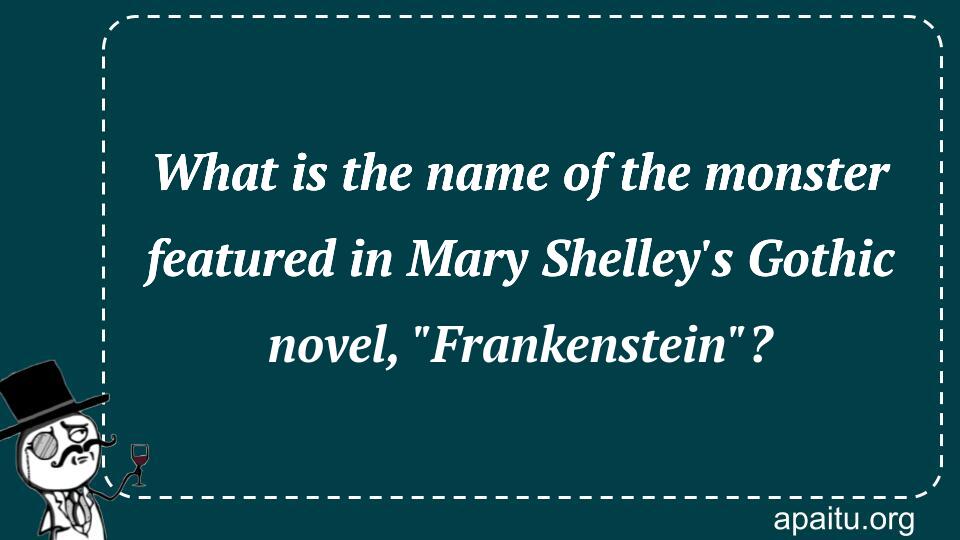Question
Here is the question : WHAT IS THE NAME OF THE MONSTER FEATURED IN MARY SHELLEY’S GOTHIC NOVEL, “FRANKENSTEIN”?
Option
Here is the option for the question :
- Igor
- Victor
- Frankenstein
- He had no name
The Answer:
And, the answer for the the question is :
Explanation:
The Frankenstein’s Monster is a fictitious character from Mary Shelley’s 1818 novel Frankenstein. Although many people assume the monster’s name is Frankenstein, he is never referred to by that name in the book. Dr. Victor Frankenstein was the scientist who created him. The creature is described by Shelley as 8-foot-tall, horribly ugly, but sensitive and emotional. When communicating with his creator, the monster refers to himself as ‘the Adam of your labours,’ although the story never gives him a name.

The Nameless Monster: Exploring the Identity of the Creature in Mary Shelley’s “Frankenstein”
Mary Shelley’s iconic Gothic novel, “Frankenstein,” has captivated readers for centuries with its tale of creation, ambition, and the consequences of playing God. At the heart of the story lies a creature so hauntingly powerful and misunderstood that it has become an enduring symbol of both horror and sympathy. However, despite its notoriety, the creature remains nameless throughout the novel, a fascinating aspect that adds depth and complexity to its character. Let us delve into the enigma of the nameless monster and explore the significance it holds within Shelley’s masterpiece.
From the moment of his creation, the creature in “Frankenstein” grapples with his existence and his place in the world. As an unnatural being, pieced together from various body parts and brought to life through scientific experimentation, he is an embodiment of the consequences of Victor Frankenstein’s ambition. Despite the creature’s physical grotesqueness, Shelley presents him as a complex being with emotions, desires, and an inherent longing for acceptance and companionship.
The absence of a name for the creature serves as a poignant reflection of his lack of identity and belonging. Denied a name by his creator, he is left adrift in a world that rejects him based on his appearance alone. Without a name, the creature is denied a sense of individuality and is dehumanized by society, further isolating him and fueling his sense of abandonment and rage.
The namelessness of the creature also highlights the power dynamics between creator and creation. Victor Frankenstein, in his pursuit of knowledge and ambition, neglects to provide his creation with a name, reducing him to a mere experiment. This act of denying the creature a name represents the imbalance of power and the disregard for the creature’s autonomy and humanity. It reinforces the notion that the creature is a possession rather than an individual deserving of compassion and understanding.
Furthermore, the absence of a name allows readers to project their own interpretations and emotions onto the character. Without a definitive label, the creature becomes a blank canvas upon which readers can reflect their fears, desires, and judgments. This open-endedness invites readers to question their own capacity for empathy and explore the complexities of human nature.
It is worth noting that popular culture often refers to the creature as “Frankenstein,” which is technically incorrect. This misattribution stems from the merging of the creature’s identity with that of his creator, Victor Frankenstein. However, Shelley’s novel distinguishes between the two, with “Frankenstein” referring to the creator and the creature remaining nameless throughout.
The significance of the nameless monster extends beyond the confines of Shelley’s novel. It has permeated the collective consciousness, becoming a symbol of the consequences of unchecked ambition and the dangers of societal rejection. The creature’s journey serves as a cautionary tale, reminding us of the importance of compassion, acceptance, and the ethical implications of scientific progress.
the nameless monster in Mary Shelley’s “Frankenstein” is a character shrouded in mystery and symbolism. Devoid of a name, the creature represents the struggle for identity, the power dynamics between creator and creation, and the capacity for empathy within society. By leaving the creature nameless, Shelley prompts readers to confront their own biases and contemplate the far-reaching consequences of neglect and rejection. The nameless monster continues to haunt our literary imagination and serves as a powerful reminder of the enduring themes explored in “Frankenstein.”